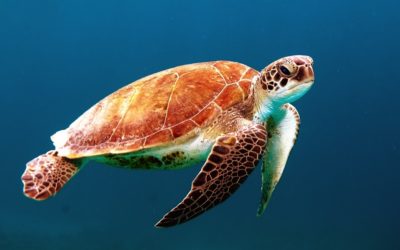
Our oceans, and their wildlife, are under threat.
Three-hundred endangered turtles were found dead off the coast of Oaxaca, Mexico, in 2018: Victims of a discarded industrial fishing net. This tragedy came just weeks after high concentrations of toxic algae killed hundreds of turtles, fish, crabs, manatees, and even a 26-foot whale shark along Florida’s Gulf Coast; The result of toxic leaks from factory farms that are fed into the ocean from the Mississippi River.
How is human activity impacting our oceans?
In 2018, scientists mapped marine “wilderness” areas around the world for the first time. They found that only 13 percent of the world’s oceans can be classed as “wilderness” or as areas that haven’t been negatively impacted by activities such as fishing, pollution, and shipping.
Very few coastal areas meet the wilderness criteria and that includes coral reefs which are normally some of the most biodiverse habitats for marine life in the ocean. Scientists found that most of the areas defined as “wilderness” fall within the Arctic, Antarctic, and around Pacific Island nations where human activity is more limited, but such areas are rapidly vanishing around the globe.
Scientists at the Wildlife Conservation Society have declared that fishing, as well as run-off waste and chemicals from industrial farms, are the two most significant ways in which humans are negatively impacting ocean ecosystems. These harmful activities, coupled with the influx of plastic pollution (46 percent of which comes from fishing nets), are disrupting ocean life and, in turn, depleting ocean resources.
Unless humanity stops contributing to the leading causes of ocean pollution, disrupted ecosystems, and declining oceanic populations, we simply won’t be able to save our oceans.

Modern fishing methods
2,700 trillion fish are trawled from the ocean each year. For every 10 tuna, sharks, and other large predatory fish that were in our oceans 50 to 100 years ago, only one is left now due to intense farming and fishing methods. If we continue fishing with these methods, scientists predict the total collapse of all fish species in less than 50 years.
Almost all of the fish and seafood we eat comes to us by way of longlining, beam, or bottom trawling, where enormous nets are dragged along the seafloor, picking up anything and everything in their path. Longlining, a technique that consists of baiting thousands of hooks along fishing lines up to one hundred miles long, snags thousands of creatures in a similarly indiscriminate fashion. While subjecting fish to a slow and distressing death, usually by suffocation, the indiscriminative nature of modern fishing techniques means that hundreds of other species are also killed in the process.
These unwanted species, referred to in the industry as “bycatch,” often include turtles, sharks, and dolphins, many of which are endangered. Every year, commercial fishing kills around 100 million sharks and as many as 300,000 whales, dolphins, and porpoises as bycatch.
Yet humans do not need to eat fish. We can get all the nutrients we need, including omega-3, from plant-based sources.

Behaviors can change
Meat consumption has an enormous impact on our oceans as well because run-off animal waste and fertilizers from industrial farms pollute our rivers and, subsequently, our coastal waters. The Environmental Integrity Project (EIP) reports that more than half of all US rivers are now unsuitable for aquatic life, largely due to nutrient pollution from industrial farming practices.
The Mississippi River, which, at 2,320 miles long, is the main drainage system on the North American continent, carries significant amounts of fertilizer, organic nitrogen, and phosphorous manure leaks from factory farms down into the Gulf of Mexico, creating the largest hypoxic zone (ocean Dead Zone) in the world. Fluorescent green algae blooms have appeared in the water off the South Coast of America as a result.
Dead Zones are areas of the ocean that would normally be teeming with life but due to pollution, most marine life has either died or left the area. The Dead Zone in the Gulf of Mexico currently spans over 3,275 square miles.

There was a time when we didn’t think twice about our excessive use of plastic bags, straws, and bottles, but gradually we’re beginning to see these products as harmful and unnecessary, and as a society, we’re making a more conscious effort to both recycle and to move away from single-use plastics. We now need to start thinking about fish and meat in the same way.













